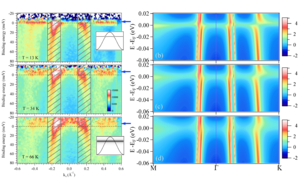P3
Lattice effects in quasi-2D Kondo systems

F. Reinert
The proposed project shall focus on the electronic structure of ternary heavy-fermion compounds including large-Z elements, as in particular Bi and Sb. This project is a direct continuation of the work in the first period of the Research Unit in which we have investigated the electronic structure of binary surface alloys based on Ce by angle resolved photoemission spectroscopy (ARPES). As demonstrated for several intermetallic alloys, large-Z elements induce a strong spin-orbit interaction and therewith a huge Rashba splitting of the electronic surface state bands. It shall be investigated in detail how this Rashba splitting of the conduction band states influences the properties of the Kondo lattice system. The lifted degeneracy affects directly the interaction between the 4f states of the Ce "impurities" and the conduction bands. It is assumed that the peculiar situation in these surface alloys results in an enhanced Kondo effect and - under certain circumstances - in a characteristic hybridization band-gap at the Fermi level, as e.g. in the Kondo insulator systems Ce3Bi4Pt3 or CeRhSb.
It was proposed recently that these latter materials represent weak topological insulators, where the strong spin-orbit splitting together with the odd-parity wavefunctions produces a situation where the criteria for a topological insulator (TI) are fulfilled. The preparation of well ordered 4f surface alloys, established in our group, will us allow to investigate this new aspect by high resolution photoemission spectroscopy (ARPES) and other surface sensitive techniques (e.g. scanning tunneling microscopy). Moreover, the reduction to a surface system has various crucial experimental advantages, as for example by avoiding photoemission final-state effects and by the disentanglement of bulk and surface properties.
However, the Ce based Kondo insulators are most likely only weakly topological, i.e. the states are rather instable to disorder. Therefore, we shall have a look at equivalent high-resolution ARPES experiments on single-crystalline bulk samples of other materials in the mixed-valence regime, to study again in detail the surface electronic structure. A comparison of the surface alloys of this proposal with bulk crystalline 4f and 5f materials, which - in contrast to the surface alloys - can be characterized by bulk sensitive methods as well, will be decisive to obtain a comprehensive picture of the complex interplay of structure, dimensionality, and electronic correlations in surface and thin film systems.
The analysis and interpretation of the photoemission data requires theoretical calculations of the electronic band structure and temperature dependent many-body effects, as being accessible within the framework of the Research Unit. This collaboration is essential to give a detailed insight into the specific single-particle properties (e.g. spin-orbit splitting, topological band structure) in presence of strong many body effects leading to Kondo screening and heavy quasi-particles near the Fermi level.

